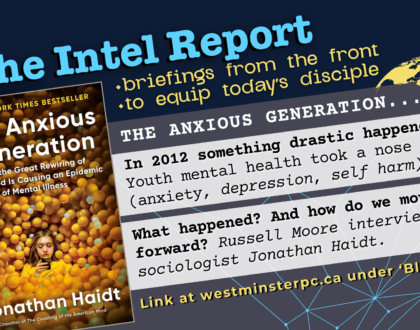Helpful Study Bibles

by Westminster
Helpful Study Bibles
Pastor Ruttan
In this podcast and blog, I’m going to highlight some helpful Study Bibles.
Perhaps you are wondering what makes a Study Bible different from a regular Bible. A regular Bible includes the text and no more. A Study Bible is meant to help you go deeper with your study. It provides introductions to each book including information about who wrote it, when it occurred in history, and the major themes it addresses. As you read through each book a Study Bible has footnotes and cross-references to clarify terms and concepts that might be confusing. Many also have small articles on themes that are relevant to specific topics raised in the text or that relate to the Christian life in general.
Here is why I’ve put this together. As followers of Jesus, it is important that we are reading the Bible every day. As I like to say, the more you get into God’s word, the more God’s word gets into you. The Bible is the primary way we learn about God’s will. At the same time, we acknowledge that it is sometimes hard to understand. To help we should be praying that the Holy Spirit illuminate us, sit under biblical preaching, and speak to others about what we are learning. But we should also seek to study the Bible.
Bernard of Clairvaux said there is a difference between reading the Bible and studying it. It’s like the difference between having a casual acquaintance and a close friend, he said. That’s where a Study Bible can help. It gives us a greater and more intimate knowledge of the text—and therefore, about the God to whom it points. As the great Reformer Martin Luther would say: “Let the man who would hear God speak, read Holy Scripture.”
Previous generations would have been baffled at the study tools we now have at our fingertips. Someone can read the Bible, study its origins, learn from the insights of others (stretching back thousands of years), and even gain basic insights into the nuances of Greek and Hebrew without going to seminary. In Psalm 81:10 the Lord says, “Open your mouth wide, and I will fill it.” What a nourishing gift. Crank open your jaw.
First, I’m going to tell you about seven general Study Bibles. Second, I’m going to mention a few other specialty Study Bibles that might be of interest to some of you.
Let’s begin.
General Study Bibles
- The NIV Zondervan Study Bible (also called the Biblical Theology Study Bible)
Publisher: Zondervan
The NIV translation of the Bible (New International Version) is the most popular translation in the English-speaking world. It’s the translation many Christians have.
If I were to recommend one Study Bible for your home this Bible (or the next one) would be it. D.A. Carson is the general editor. The notes highlight major and significant themes. That is one of its particular strengths. Some Study Bibles seem to get into the weeds and fail to draw attention to the bigger picture about what is happening with the author’s intention or with the story as a whole. Not so with this Bible.
It has helpful footnotes and cross references. The introductions to each book include information about the author, its historical setting, and key themes. There are also maps and chronological timelines.
One of the things I like about this Study Bible is the special articles. They cover topics like Creation, Sin, Covenant, the Kingdom of God, Wisdom, the Gospel, Shalom, etc. They are concise (meaning they are to-the-point and not too long), but long enough to have the meat and potatoes that you are looking for.
- The ESV Study Bible
Publisher: Crossway
In the previous review I said that I would also put this Study Bible right at the top of the list. Like the NIV Study Bible, it has good footnotes, cross references, book introductions, and maps.
A difference, obviously, is the translation. It’s the ESV which I have personally been using for preaching and study. At this point, I won’t get into the different kinds of Bible translations. These days there are a lot of them. It’s a blessing to all of us. There is the New International Version (NIV), the English Standard Version (ESV), the Christian Standard Bible (CSB), the New Living Translation (NLT), the New English Translation (NET), and many more. If you want to know more about the different approaches to translation which have resulted in these different versions, you can link below to a blog I did called “Explaining the Differences Between Bible Translations.”
Before we move on, let me share a final word about the ESV Study Bible. Its articles zero-in a bit closer on some modern issues that people might be wrestling with, including sexuality, government, bioethics and war. These articles aren’t very long, but they are a helpful guide.
- The NLT Illustrated Study Bible
Publisher: Tyndale House
The translation is the New Living Translation which is more conversational in tone. One of the noteworthy things about this Bible is how visually pleasing it is. There are lots of colours and pictures. It too has solid notes and introductions to the various books.
One of the strengths of this Study Bible is that it has a lot of small features scattered through the books. For example, in Luke 1 which teaches us about the infancy of Jesus, it has a feature on his mother Mary. A few pages later there is a short section on what first-century synagogues would have looked like with a diagram. At the back there is a listing of these different features so you can track them down if you’re looking for more information on something specific.
- The Life Connections Study Bible (For Personal or Small Group Study)
Publisher: Holman
This Study Bible is a Christian Standard Bible (CSB) translation. It also has book introductions which provide information about the author, background and purpose of each book. The footnotes are a bit less thorough, but they’re still quite good.
Here is what is unique about this Study Bible. Along the side of each page there are questions you can ask yourself or others which are based on the story you are reading. That’s why the subtitle says it is for personal or small group study. It’s designed to help facilitate conversation. There are also suggestions about how to apply a certain teaching to your life.
- The Life Application Study Bible
Publisher: Zondervan
From what I understand, this Study Bible has become quite popular. It too is an NIV translation. It also has book introductions and footnotes.
One of the features I like the most about this Bible is the character profiles. For example, in the book of Nehemiah there is a blurb about Nehemiah himself, his strengths and accomplishments as a person, and some lessons that the rest of us can learn from his life. This is repeated throughout the Bible for various other characters.
I should say that the footnotes are a bit less comprehensive than other Study Bibles. They are more geared toward application. Instead of focusing on background and context to help you with your interpretation, they tend to jump right to application, hence doing some of that work for you. So in my estimation, it’s less in-depth, but still helpful.
- The Reformation Study Bible
Publisher: Reformation Trust (A Division of Ligonier Ministries)
This Bible has the ESV as its translation. Ligonier Ministries has emerged in the wake of the ministry of the well-respected preacher and teacher R.C. Sproul. He was the General Editor of this Study Bible.
It has good book introductions and notes. In many ways it feels like the ESV Study Bible with perhaps a bit less detail. The articles are solid and tend to focus on key themes in Reformed Protestantism such as covenant theology, the inerrancy of Scripture, God’s grace, etc. It also includes a series of ‘theological notes’ which crop up as small insets to the text as you go through the Bible.
As an added bonus there are various creeds in the back such as the Apostles’ Creed, the Heidelberg Catechism and the Westminster Confession.
- The Reformation Heritage KJV Study Bible
Publisher: Reformation Heritage Books
The text of this Study Bible is the King James Version. It was published in 1611 and has exerted a massive influence in the English-speaking world. Although it is no longer the dominant English translation, some people continue to use it. The thees and thous have fallen out of use, but there is a certain poetry and majesty to the words.
I include this Study Bible here because the footnotes are solid and, like some others already mentioned, there are a lot of strong-but-short articles about how to live as a Christian. In fact, there is a whole section about it in the back. Themes include being united with Christ, fellowship, self-denial, godly contentment, humility, love, coping with criticism, assurance, God’s mercy, the soul, and heaven and hell.
Perhaps the most helpful feature of this Study Bible is this. At the end of each chapter in the footnotes the are “thoughts for personal/family worship.” I know this is a passion of Joel Beeke, the editor. There are some comments and questions to focus your devotional reading either alone or in a family setting. These are substantive, not fluffy.
Those are seven suggestions for Study Bibles which help you better understand both the specific details about what you are reading and also the big picture.
Specialized Study Bibles
Second, let me briefly highlight a few others that have a more specific focus. If you were to only get one, I would suggest something from what I’ve already mentioned, but one of these specialty Study Bibles might strike a particular chord as well.
The NET Bible Full Notes Edition from Thomas Nelson is a gem. It is focused exclusively on the text itself (there are no book introductions) and has comprehensive notes on the translation of Hebrew, Aramaic and Greek words and expressions. I think it’s probably too in-depth for beginners, but if you are preaching sermons or preparing for serious Bible studies, this is a great asset. It’s also a great help for someone like me who has studied Hebrew and Greek but who isn’t taking classes on an ongoing basis. (A few years of Hebrew and Greek does not an expert make!) A Study Bible like this keeps me in that world and brings attention to details and meanings related to the original languages.
The Church History Study Bible (ESV) from Crossway is something I’ve recently picked up. It has book introductions, although they are quite short. What makes this one different is that the notes are exclusively quotes from notable Christian scholars, preachers and teachers through history. In preparing for this I opened the Bible randomly to the psalms. On that page happened to be quotes from Martin Luther, John Calvin, Herman Bavnick, Augustine, Charles Spurgeon, George Whitefield, Martyn Lloyd-Jones, and Charles Hodge. You get the picture.
The Ancient Faith Study Bible (CSB) from Holman Publishers is similar to the Church History Study Bible just mentioned. The main difference is that the quotes are from the Church Fathers to the end of the sixty century (generally speaking). There are also some short-but-helpful biographies of these early and influential leaders in the church.
The Holy Land Illustrated Bible (CSB) from Holman Publishers looks a bit like the NLT Illustrated Study Bible in that it is very visually pleasing. As the name suggests it has lots of pictures of ancient artifacts and locations as well as archaeological discoveries. There are also articles like “Who were the Samaritans?” or “Bread Making in the Ancient World.” These are intended to give us more understanding about what things were like in their historic context. There are also short ‘digging deeper’ sections that are an added bonus. However, there are fewer line-by-line notes to the text itself; that’s a downfall.
The Archaeology Study Bible (ESV) from Crossway focusses on just that: insights from the world of archaeology. In recent times there have been many, many discoveries which help us better understand the world of the Bible. This resource highlights them and also includes many notes about ancient documents and other ancient religions insofar as they help us appreciate the world of the biblical writers and characters. If you flip through the Gospel of John you’ll see helpful entries about the Pool of Siloam, the tomb of Lazarus, or women in the first century. In other worlds, there is a lot of rich content to digest.
The NIV Cultural Backgrounds Study Bible by Zondervan has good book introductions and notes, but focuses mostly on the social and cultural norms of the day which may illuminate various meanings in the text. For example, when I was preparing this I turned randomly to Mark 6. The notes highlight what an ancient village was like, the significance of loaves and fish in a daily diet, and what is meant by ceremonial washing. Since so much time has passed between then and now, we often have to do some research to learn about ancient customs or practices which the original readers of the text already knew, but which we may not. Did people belief in the evil eye? How were the roles of men and women different? Are the biblical stories consistent with what happened in the ancient world, and if so, how does that give us more confidence in what we are reading? This Study Bible brings these questions and issues to our attention, and we are the better for it.
I hope and pray that this blog and podcast has been helpful. If you have other recommendations I encourage you to leave a comment.
Our final word is with Psalm 119, the longest chapter in the Bible. It is an extended reflection on the excellences of the word of God. May our prayer be that of verse 125: “I am your servant; give me understanding…”
Link:
Explaining the Differences Between Bible Translations
Recommended Posts

10 Unpopular things Jesus said
July 23, 2024

The Intel Report No.2 – Demons, Possession & Exorcism
July 17, 2024
